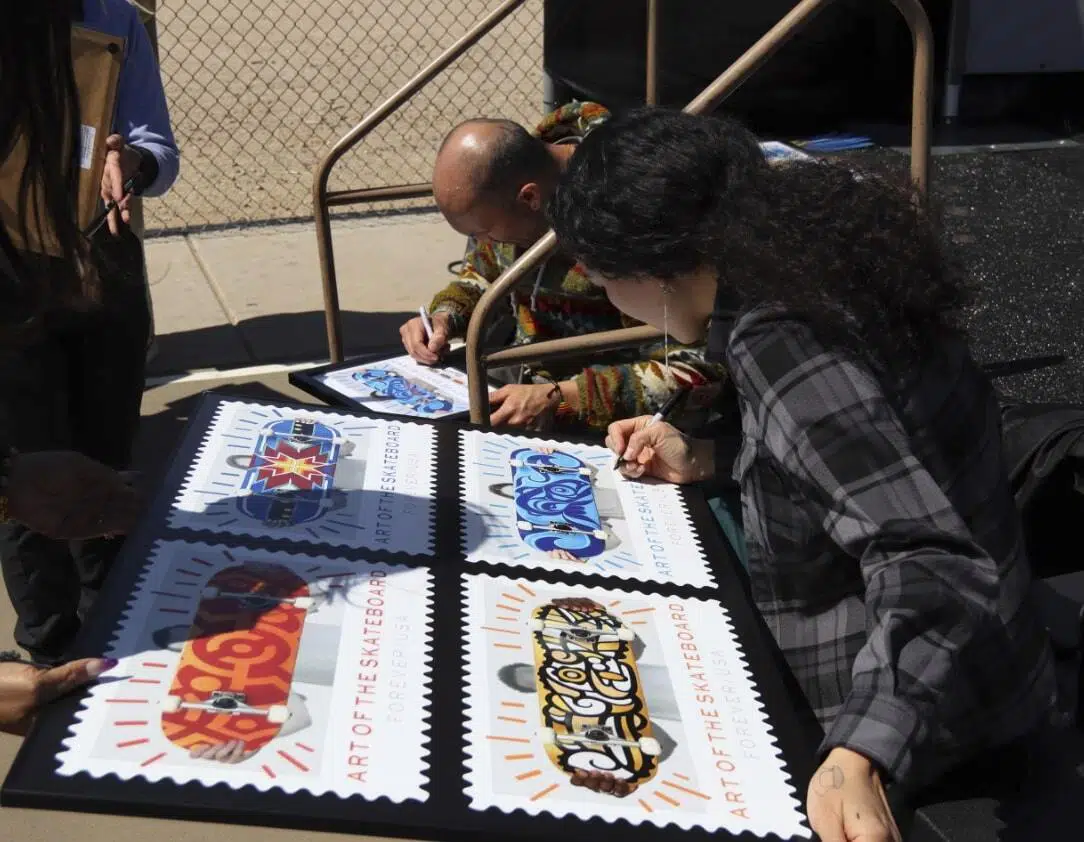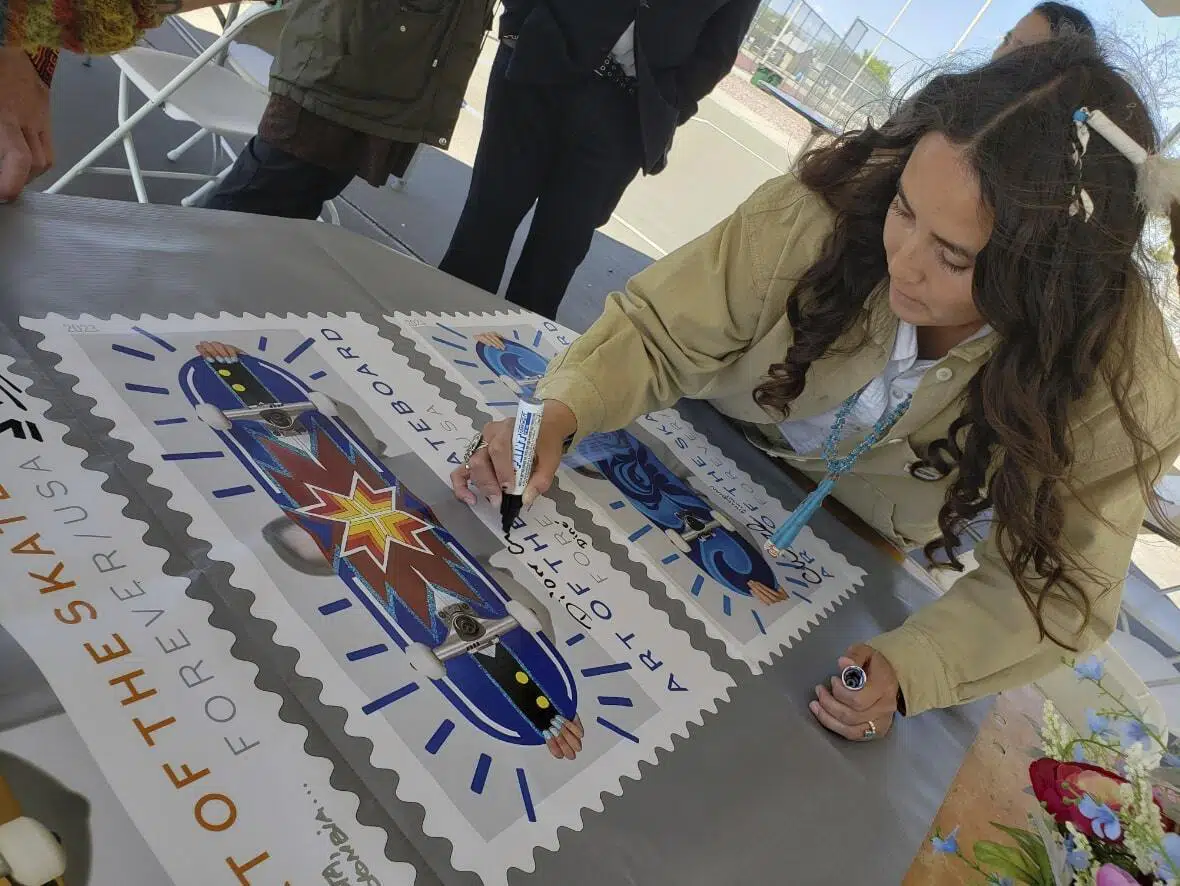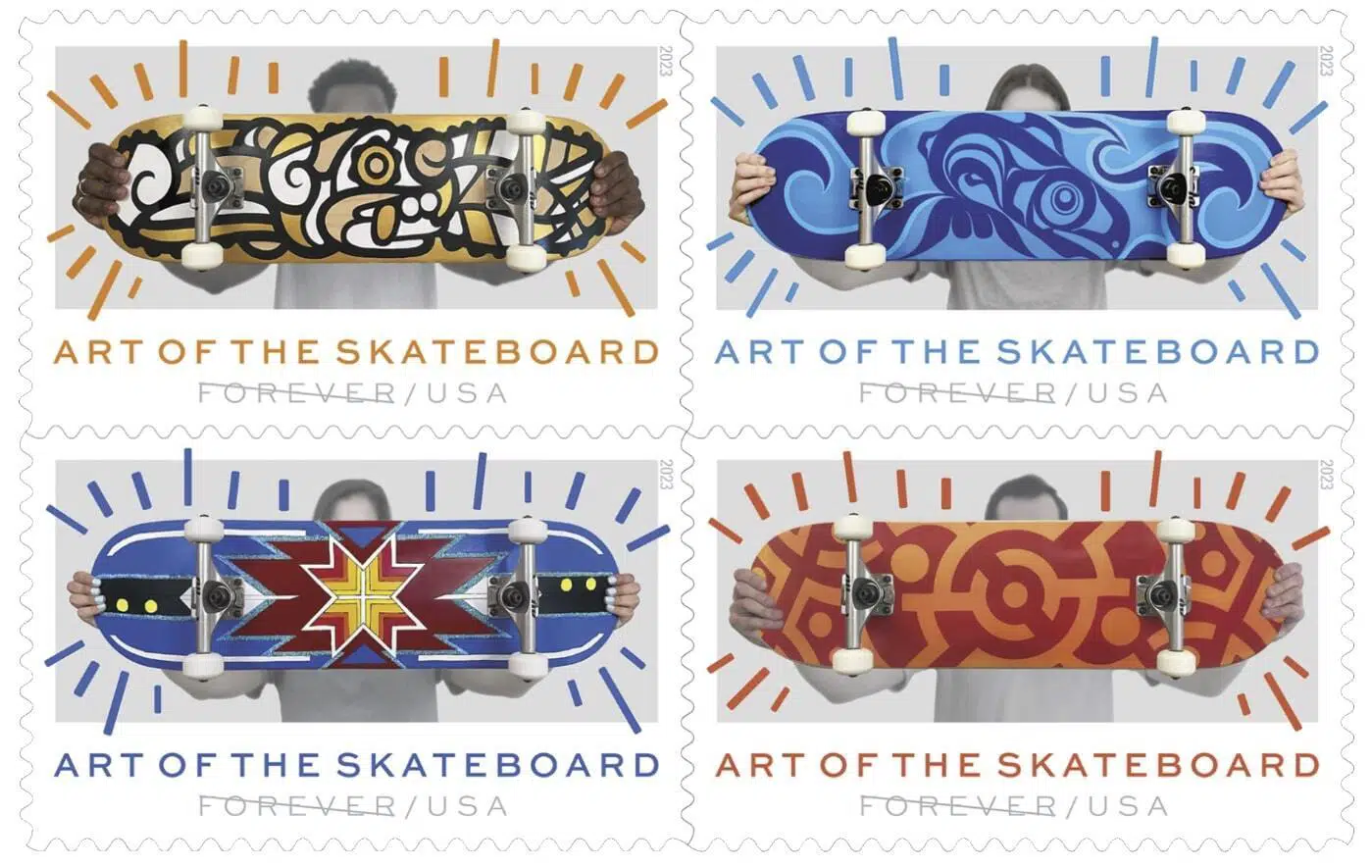Indigenous artists help skateboarding earn stamp of approval
By TERRY TANG

1 of 17
Expert skateboarder Di'Orr Greenwood, an artist born and raised in the Navajo Nation in Arizona and whose work is featured on the new U.S. stamps, rides her skateboard next to her artworks in the Venice Beach neighborhood in Los Angeles Monday, March 20, 2023. On Friday, March 24, the U.S. Postal Service is debuting the "Art of the Skateboard," four stamps that will be the first to pay tribute to skateboarding. The stamps underscore how prevalent skateboarding has become, especially in Indian Country, where the demand for designated skate spots has only grown in recent years. (AP Photo/Damian Dovarganes)
PHOENIX (AP) — Years ago, skateboarding was branded as a hobby for rebels or stoners in city streets, schoolyards and back alleys. Those days are long gone.
Skateboarding, which has Native Hawaiian roots connected to surfing, no longer is on the fringes. It became an Olympic sport in 2020. There are numerous amateur and professional skateboarding competitions in the U.S. And on Friday, the U.S. Postal Service is issuing stamps that laud the sport — and what Indigenous groups have brought to the skating culture.
Di’Orr Greenwood, 27, an artist born and raised on the Navajo Nation in Arizona whose work is featured on the new stamps, says it’s a long way from when she was a kid and people always kicked her out of certain spots just for skating.
“Now it’s like being accepted on a global scale,” Greenwood said. “There’s so many skateboarders I know that are extremely proud of it.”
The postal agency ceremoniously unveiled the “Art of the Skateboard” stamps in a Phoenix skate park as a skateboarding competition was going on nearby.
The stamps feature skateboard artists from around the country, including Greenwood and Crystal Worl, who is Tlingit Athabascan. William James Taylor Jr., an artist from Virginia, and Federico “MasPaz” Frum, a Colombian-born muralist in Washington, D.C., round out the quartet of featured artists. Everyone but Taylor was in attendance.
“Over time skateboards themselves have become works of art highlighting artists’ creativity, boldness and energy,” William Zollars, of the USPS Board of Governors, told an audience of city officials and supporters. “As an American institution older than the country itself, the Postal Service is always looking for ways to highlight and honor stories and histories that are unique to the United States.”
The stamps underscore the prevalence of skateboarding, especially in Indian Country where the demand for skate parks is growing.
The artists see the stamp as a small canvas, a functional art piece that will be seen across the U.S. and beyond.
“Maybe I’ll get a letter in the mail that someone sent me with my stamp on it,” said Worl, 35, who lives in Juneau, Alaska. “I think that’s when it will really hit home with the excitement of that.”
Antonio Alcalá, USPS art director, led the search for artists to paint skate decks for the project. After settling on a final design, each artist received a skateboard from Alcalá to work on. He then photographed the maple skate decks and incorporated them into an illustration of a young person holding up a skateboard for display. The person is seen in muted colors to draw attention to the skate deck.
Alcalá used social media to seek out artists who, besides being talented, were knowledgeable about skateboarding culture. Worl was already on his radar because her brother, Rico, designed the Raven Story stamp in 2021, which honored a central figure in Indigenous stories along the coast in the Pacific Northwest.
The Worl siblings run an online shop called Trickster Company with fashions, home goods and other merchandise with Indigenous and modern twists. For her skate deck, Crystal Worl paid homage to her clan and her love of the water with a Sockeye salmon against a blue and indigo background.
She was careful about choosing what to highlight.
“There are certain designs, patterns and stories that belong to certain clans and you have to have permission even as an Indigenous person to share certain stories or designs,” Worl said.





This image provided by the U.S. Postal Service shows its new the "Art of the Skateboard" Forever stamps. The agency on Friday, March 24, 2023, is debuting the stamps at a Phoenix skate park. The stamps feature designs from four artists from around the country, including two Indigenous artists. (Courtesy of USPS via AP)
The only times Navajo culture has been featured in stamps is with rugs or necklaces. Greenwood, who tried out for the U.S. Women’s Olympic skateboarding team, knew immediately she wanted to incorporate her heritage in a modern way. Her nods to the Navajo culture include a turquoise inlay and a depiction of eagle feathers, which are used to give blessings.
“I was born and raised with my great-grandmother, who looked at a stamp kind of like how a young kid would look at an iPhone 13,” Greenwood said. “She entrusted every important news and every important document and everything to a stamp to send it and trust that it got there.”
Skateboarding has become a staple across Indian Country. In Oregon, the Confederated Tribes of Warm Springs will reopen a refurbished skate park March 29 thanks to a partnership with pro skateboarder Tony Hawk’s nonprofit, The Skatepark Project. Skateboarders on the Fort Apache Indian Reservation in eastern Arizona recently got funding from there, too. A skate park opened in August on the Hopi reservation. Youth-organized competitions take place on the Pine Ridge Indian Reservation in South Dakota.
Dustinn Craig, a White Mountain Apache filmmaker and “lifer” skateboarder in Arizona, has made documentaries and short films on the sport. The 47-year-old remembers how skateboarding was seen as dorky and anti-establishment when he was a kid hiding “a useless wooden toy” in his locker. At the same time, Craig credits skateboarding culture as “my arts and humanities education.”
So he is wary of the mainstream’s embrace, as well as the sometimes clique-ish nature, of today’s skateboarding world.
“For those of us who have been in it for a very long time, it’s kind of insulting because I think a lot of the popularity has been due to the proliferation of access to the visuals of the youth culture skateboarding through the internet and social media,” Craig said. “So, I feel like it really sort of trivializes and sort of robs Native youth of authenticity of the older skateboard culture that I was raised on.”
He acknowledges that he may come off as the “grumpy old man” to younger Indigenous skateboarders who are open to collaborating with outsiders.
The four skateboards designed by the artists will eventually be transferred to the Smithsonian National Postal Museum, said Jonathan Castillo, USPS spokesperson.
The stamps, which will have a printing of 18 million, will be available at post offices and on the USPS website beginning Friday. For the artists, being part of a project that feels low-tech in this age of social media is exciting.
“It’s like the physical thing is special because you go out of your way to go to the post office, buy the stamps and write something,” Worl said.
___
Terry Tang is a member of The Associated Press’ Race and Ethnicity team. Follow her on Twitter at https://twitter.com/ttangAP

























